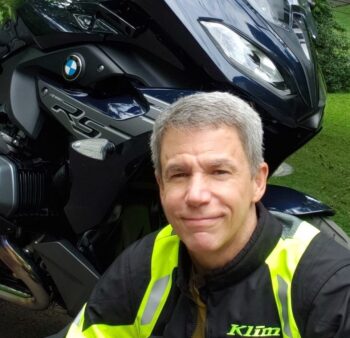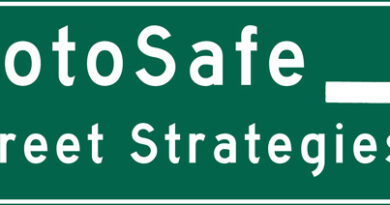All my fault
I’m riding down a straight highway, minding my own business. Traffic around me is light and easy to negotiate. The weather is beautiful. My bike is running perfectly. I feel good in the saddle. Suddenly, out of nowhere, a titanic SUV appears in my left peripheral vision and immediately cuts across my lane to make a right-side exit they almost passed. Had I not slowed at a rate only a motorcycle can achieve, their rear bumper would have clipped my front wheel! It was a frighteningly narrow escape.
Approaching from my flank, the driver must have seen me, but I may have disappeared in their blind spot as they passed. Maybe they misjudged how far ahead they’d have to get to clear me with their lengthy vehicle. After all, they were focused on making that exit before completely missing their chance. It was me who hadn’t seen them, at least not when I should have. The SUV didn’t really come “out of nowhere.” I’d noticed it in my mirror several times over the prior mile as I surveyed my surroundings. It had been hanging at a constant distance, blending innocuously into the sparse collection of other cars and trucks in view. In the low-stress environment, I’d become complacent, checking my mirrors less and less frequently, and leaving myself blithely unaware of the SUV’s last-minute mad dash. I could rage at the driver’s recklessness, but the more appropriate exclamation would be, “Mea culpa!”

Regardless of any blame someone might levy against that driver—inattentiveness to the approaching exit, veering across my lane without adequate clearance, etc.—I was responsible for being caught off-guard. Had the near miss been a hit, it wouldn’t have been any less consequential for me because the SUV driver was technically the person who’d misbehaved. As the one who was most vulnerable to catastrophic fallout from a collision, it behooved me to be vigilant and protect my own interests, regardless of who might be held liable for such an event after the fact. I had no control over that driver’s choices or actions, only my own. An ounce of prevention isn’t only worth a pound of cure, it could be worth a pound of flesh—or in my case, 160 pounds of flesh. I have to take full responsibility for avoiding contact with other vehicles; “fault,” as it’s usually construed, is completely irrelevant. I won’t feel any better about a lost leg or spinal cord injury because it was caused by someone else’s error, nor will I get a replacement life because I was fouled.

As a psychologist who has worked extensively with abused and neglected children (in both child and adult phases of their lives), I’m aware of a parallel here. Children, who are physically lesser than and utterly dependent upon their caregivers, must adopt a stance similar to what I just laid out. They cannot control adults who ignore or mistreat them. Their misery is unmitigated by blaming others, and they rarely have access to an outside authority who can ensure justice prevails. It’s incumbent upon them to do what’s necessary to decrease their own vulnerability and suffering, fairness be damned. Regardless of who’s actually at fault, such kids must assume all problems are their responsibility. It’s what they’re usually told, and it’s simply pragmatic. They do everything they can to avoid their parents’ wrath and extract whatever care is available from whomever they can access. This typically results in grossly distorted perspectives on self and world, along with contorted interpersonal dynamics. These are all likely to be quite maladaptive outside their family of origin, resulting in numerous difficulties later in life, but they’re essential to their survival during childhood.
If a parent condemns a child for having the normal, unavoidable needs, limitations, and weaknesses of a child, the child must agree these things are bad and learn to hate and hide them if they’re to have at least some chance of avoiding the parent’s punishment and/or rejection. There’s no room for arguing another arrangement ought to exist. Depending on the developmental level of the child, they probably couldn’t articulate such a position, anyway, but if they could it would either fall on deaf ears or make matters worse. The only practical option is modifying their own beliefs and behavior. Likewise, if drivers on the road treat me and my motorcycle as invisible, I must accept this characterization as though it’s true if I’m to survive. Yes, I can wear hi-viz gear and outfit my bike with conspicuity lighting, but I’d better not assume this will protect me from every car that might turn into my path. I must embrace the mindset that any problem arising between myself and another vehicle will be all my fault despite such measures.
Just as the abused child must be forever vigilant for subtle cues that an explosively destructive caregiver’s mood is about to become dangerous, I need to be perpetually alert to any hint a driver is inattentive, erratic, or incompetent. And like the abused child, I can’t afford to let my own anger or self-assertion inflame situations wherein the power and vulnerability differentials are heavily weighted in favor of the other party. I need to stay calm, strategic, and alert for ways to escape any situation that contains a threat, since I have no hope of winning a fight with a car or truck. This is a kind of “healthy paranoia” for the street, just as the child’s skewed adaptation is necessary and appropriate in the context of a perilous home environment. The difference is I can turn on this mode of functioning while riding and then turn it off when I’m away from my bike; a child whose personality has been shaped by such awful experiences may remain locked in this way of being for the rest of their life.
In a successful course of psychotherapy, people who’ve endured traumatic relationships with their early dependency figures learn that not everyone will mistreat them similarly. While there are certainly others out there like the antagonists of their youth, there are also people who are kind, stable, reasonable, and consistently invested in cooperative, mutually supportive engagement. Survivors of abuse and neglect must develop the ability to distinguish between safe people and unsafe people, rather than erring on the side of caution and treating everyone as dangerous or uninterested (which effectively prevents them from getting any of the good stuff many human beings have to offer). They must also come to understand themselves as something other than a relentlessly burdensome nuisance or an automatic cause of retaliation, even as they become aware of ways they may unwittingly perpetuate their past experiences in the present.

As motorcyclists, we would derive no pleasure from our beloved avocation if all we did in the saddle was fear disaster. We, too, have to learn which things genuinely warrant alarm in our immediate surroundings and which are phantasmagoric products of our imagination. Scanning and planning are not the same as constantly conjuring grisly scenes of horrific injury. Knowing—really knowing on the basis of successful practice, not merely theory—what evasive maneuvers we’re capable of executing decreases our anxiety about encountering trouble for which we’re realistically prepared. When I’m confident I can stop in time or swerve effectively if the driver in front of me slams on their brakes, I don’t have to worry about that happening; I just have to keep an eye on it and stay ready. Also, if I become too self-critical about my shortcomings, I’ll end up distracted, demoralized, and more likely to make additional mistakes. Instead, I must take information about my performance, good and bad, and use it to determine where I need improvement, without whipping myself in the process. Energy spent on whipping is energy not spent on growth.
This obviously doesn’t mean I can actually evade every potential mishap on the road; I’m not omniscient or omnipotent, even if I assume the level of accountability described here. All I can do is minimize the odds of a crash by maximizing my preventative efforts. Hence, this issue of taking full responsibility isn’t only a matter of my attitude on a ride. It includes other things, like pursuing rider training, practicing skills on a routine basis, wearing high quality gear, and maintaining my machine. All of these are ways to realistically reduce the risks inherent in traveling in close proximity to vehicles that can very easily hurt or kill me, vehicles controlled by drivers who may frequently be aggressive, self-absorbed, impaired, unconcerned with my wellbeing, or even oblivious to my presence. Only by being steadily attentive to the negative possibilities can I be free to enjoy all the positives that make riding worthwhile—and live to do the same again tomorrow.
Mark Barnes is a clinical psychologist and motojournalist. To read more of his writings, check out his book Why We Ride: A Psychologist Explains the Motorcyclist’s Mind and the Love Affair Between Rider, Bike and Road, currently available in paperback through Amazon and other retailers.



